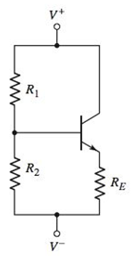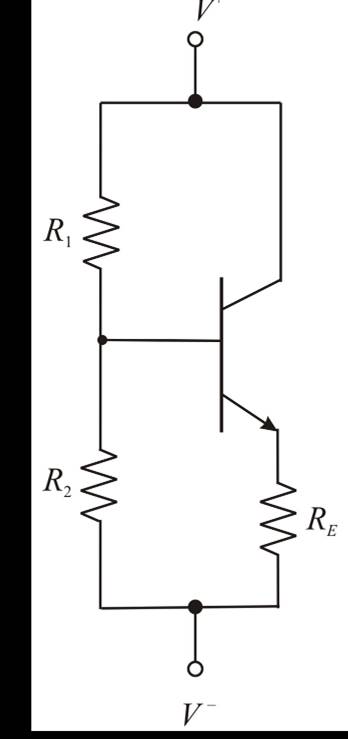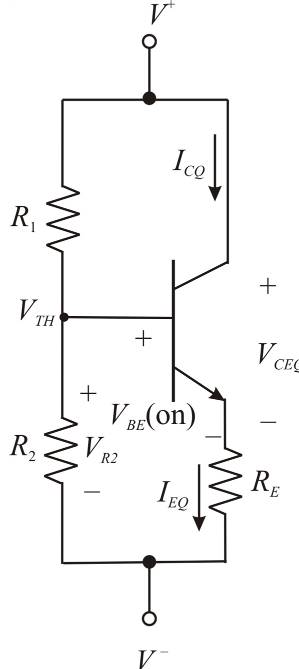
The emitter−follower circuit shown in Figure P5.89 is biased at

Figure P5.89
The design parameters of the circuit.
To select: Five percent tolerance values of resistances.
To find: The range of the Q- point values.
Answer to Problem D5.89DP
The design parameters of the circuit are:
Five percent tolerance resistance
The range of the current is
Explanation of Solution
Given:
The given circuit is shown in Figure 1

Figure 1
Calculation:
Mark the current as well as other parameters and then redraw the circuit.
The required diagram is shown in Figure 2

Figure 2
The Thevenin equivalent bias circuit is shown in Figure 3

Figure 3
The value of the base current is calculated as,
Substitute
Apply KVL in Figure 2
The expression for the value of the Thevenin resistance is given by,
Substitute
Apply KVL to figure 3.
Substitute
The expression for the Thevenin voltage is evaluated as,
Substitute
The expression for the Thevenin resistance is given by,
From the five percent tolerance resistance
Now consider the value of
The value for the Thevenin resistance is calculated as,
Substitute
Substitute
The expression for the collector current is given by,
Substitute
Apply KVL in Figure 2
Consider the value of
The value for the Thevenin resistance is calculated as,
Substitute
Substitute
The expression for the collector current is given by,
Substitute
Apply KVL in Figure 2
The Q- point values of the current and voltage for the range of
Want to see more full solutions like this?
Chapter 5 Solutions
Microelectronics Circuit Analysis and Design
- In your own words, briefly describe the basic operation of an E-MOSFET.arrow_forwardDraw the circuit diagram of a resistance–capacitance coupled common-source amplifier.arrow_forwardHow would you characterize power BJT in comparison with power MOSFET? Illustrate your answer by drawing structures and explaining transient response of both devices?arrow_forward
- Fixed-bias configuration, Emitter-bias configuration, and Voltage-divider configuration- rank these three configurations based on their provided stability (i.e. ? independency)to the operating point. Use mathematical terms/equations to explain and justify yourarrow_forward5- a-) Define the MOSFET in the figure, explain by drawing its input and output circuit characteristics.b-) Since k=0.1 mA/V2, VGS=5V and VT=2.5V for this MOSFET, find the VDS voltage using the circuit.arrow_forwardDescribe step by step how MOSFET works and its applications.arrow_forward
- circuit shown in the figure, Kn = 2mA / V2, VIN = 0.7V for Mi mosfeti. So, what kind of relationship should there be between R1 and R2 resistance for mosfet to work at saturation?arrow_forwardDetermine the exact voltage gain for the unloaded emitter-follower in following Figure ?arrow_forwardExplain the construction and working of the Depletion MOSFET, with characteristics curve.arrow_forward
- What is the primary function of a bipolar junction transistor? Briefly discuss you answer.arrow_forwardDiscuss about! Depletion Type MOSFET Construction Systematic Diagrams Working Applicationsarrow_forward"Bias voltage applied to the emitter electrode of a transistor offers greater stability over bias toward its base." Why? How does that actually work? My professor wants a detailed, engineering level explanation for this, and I am struggling to understand this to the degree he is asking. He says having both a positive and negative voltage source at the emitter bias is not necessary, and won't accept this as part of the explanation. Thanks!arrow_forward
 Introductory Circuit Analysis (13th Edition)Electrical EngineeringISBN:9780133923605Author:Robert L. BoylestadPublisher:PEARSON
Introductory Circuit Analysis (13th Edition)Electrical EngineeringISBN:9780133923605Author:Robert L. BoylestadPublisher:PEARSON Delmar's Standard Textbook Of ElectricityElectrical EngineeringISBN:9781337900348Author:Stephen L. HermanPublisher:Cengage Learning
Delmar's Standard Textbook Of ElectricityElectrical EngineeringISBN:9781337900348Author:Stephen L. HermanPublisher:Cengage Learning Programmable Logic ControllersElectrical EngineeringISBN:9780073373843Author:Frank D. PetruzellaPublisher:McGraw-Hill Education
Programmable Logic ControllersElectrical EngineeringISBN:9780073373843Author:Frank D. PetruzellaPublisher:McGraw-Hill Education Fundamentals of Electric CircuitsElectrical EngineeringISBN:9780078028229Author:Charles K Alexander, Matthew SadikuPublisher:McGraw-Hill Education
Fundamentals of Electric CircuitsElectrical EngineeringISBN:9780078028229Author:Charles K Alexander, Matthew SadikuPublisher:McGraw-Hill Education Electric Circuits. (11th Edition)Electrical EngineeringISBN:9780134746968Author:James W. Nilsson, Susan RiedelPublisher:PEARSON
Electric Circuits. (11th Edition)Electrical EngineeringISBN:9780134746968Author:James W. Nilsson, Susan RiedelPublisher:PEARSON Engineering ElectromagneticsElectrical EngineeringISBN:9780078028151Author:Hayt, William H. (william Hart), Jr, BUCK, John A.Publisher:Mcgraw-hill Education,
Engineering ElectromagneticsElectrical EngineeringISBN:9780078028151Author:Hayt, William H. (william Hart), Jr, BUCK, John A.Publisher:Mcgraw-hill Education,





